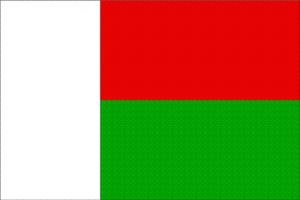Language/Plateau-malagasy/Grammar/How-to-Use-Be
Hi Plateau Malagasy learners! 😊
In this lesson, we will learn how to use the verb "be" in Plateau Malagasy. We will go through different forms of the verb and their usage. We will also understand how to use "be" in negative and interrogative forms.
Once you've mastered this lesson, take a look at these related pages: Pronouns and Their Usage & Negation.
What is the Verb "Be"[edit | edit source]
The verb "be" is used to indicate the existence or presence of something or to describe a state of being. It is one of the most common and versatile verbs in the English language. The Plateau Malagasy equivalent of "be" is "ho" which is used in a variety of contexts. Let's understand how to use "ho" in different forms.
Present Tense[edit | edit source]
In the present tense, "be" is used to describe a state of being or existence in the present. It is formed by using "ho" as the auxiliary verb followed by the base form of the main verb.
| Plateau Malagasy | Pronunciation | English |
|---|---|---|
| aho dia mpianatra | əhu dɪə mpiənaʈrə | I am a student. |
| ianao dia mpampianatra | ianəʊ dɪə mpampiənaʈrə | You are a teacher. |
| izay no ancian'ny tanàna | izə nəw əntsjanən ny tanəna | That is the oldest house in the city. |
In the above examples, "ho" is used as the auxiliary verb to form the present tense. It is followed by the base form of the main verb, which could be a noun or an adjective.
Past Tense[edit | edit source]
In the past tense, "be" is used to describe a state of being or existence in the past. It is formed by using "nanao" as the auxiliary verb followed by the base form of the main verb.
| Plateau Malagasy | Pronunciation | English |
|---|---|---|
| nonina aho | nonin əhu | I was there. |
| nonin'i Dada ianao | nonin idada janəʊ | You were with Dada. |
| nonin'ny androany ny fotoana ho vita amin'ny antony | nonin n androan ny fɔtoana hu vita əmɪn ny an̥tɔn | The time was up for the reason today. |
In the above examples, "nanao" is used as the auxiliary verb to form the past tense. It is followed by the base form of the main verb, which could be a noun or an adjective.
Future Tense[edit | edit source]
In the future tense, "be" is used to describe a state of being or existence in the future. It is formed by using "ho" as the auxiliary verb followed by the future tense marker "hatao" and the base form of the main verb.
| Plateau Malagasy | Pronunciation | English |
|---|---|---|
| hitan'ny taraina ny rano | hitan nə taɾajnə n ranu | The water will reach the shore. |
| hatao mpampianatra ianao raha tsy lahy ny anaranao | hatəw mpampiənaʈrə janəʊ rahə tsə lahi n anaranəw | You will become a teacher if your name is not male. |
| ho mpianatra aho maraina | hu mpiənaʈrə əhu maɾajna | I will be a student in the morning. |
In the above examples, "ho" is used as the auxiliary verb to form the future tense. It is followed by the future tense marker "hatao" and the base form of the main verb, which could be a noun or an adjective.
Negative Form[edit | edit source]
To form negative sentences using "be", we add the negative particle "tsy" after "ho" or "nanao".
| Plateau Malagasy | Pronunciation | English |
|---|---|---|
| aza ho mpianatra ianao | azə hu mpiənaʈrə janəʊ | You are not a student. |
| tsy nanao sary izy | tsə nănaw saɾə izi | He was not taking pictures. |
| tsy ho mpianatra aho hanitra | tsə hu mpiənaʈrə əhu hanɪtʁə | I will not be a student in the evening. |
In the above examples, "tsy" is added after "ho" or "nanao" to form the negative form.
Interrogative Form[edit | edit source]
To form interrogative sentences using "be", we place the auxiliary verb "ho" or "nanao" at the beginning followed by the subject and then the base form of the main verb.
| Plateau Malagasy | Pronunciation | English |
|---|---|---|
| iza ho mpianatra? | izə hu mpiənaʈrə? | Who is a student? |
| nanao inona ianao tamin'ny andro alina? | nanaw inonə janəʊ tamɪn n andro alina | What were you doing last night? |
| ho mpianatra ve aho? | hu mpiənaʈrə və əhu? | Will I be a student? |
In the above examples, the auxiliary verb "ho" or "nanao" is placed at the beginning of the sentence followed by the subject and the base form of the main verb.
Dialogue Example[edit | edit source]
Here's an example dialogue between two people using the verb "be":
- Person 1: Vao tonga dia mpianatra hianao? (Did you just come here to study?)
- Person 2: Eny ho mpianatra izay. (Yes, I'm here to study.)
- Person 1: Tsy ho mpianatra intsony ve ianao androany? (Are you not a student anymore today?)
- Person 2: Eny, tsy ho mpianatra intsony aho. (Yes, I'm not a student anymore today.)
Conclusion[edit | edit source]
Using the verb "be" in Plateau Malagasy is quite simple once you understand the various forms and their usage. Remember to practice these forms with examples and find native speakers to ask them any questions about using "be" in Plateau Malagasy. To improve your Plateau Malagasy Grammar, you can also use the Polyglot Club website. Find native speakers and ask them any questions!
➡ If you have any questions, please ask them in the comments section below.
➡ Feel free to edit this wiki page if you think it can be improved. 😎
Now that you've completed this lesson, don't stop learning! Check out these related topics: Basic Sentence Structure & Plurals.

